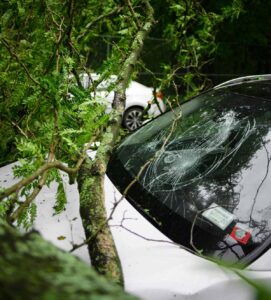
Navigating the world of auto insurance can be a complex task. Understanding the various types of coverage available is crucial. One such coverage that often raises questions is glass coverage.
What exactly is glass coverage in an auto insurance policy? How does it differ from full glass coverage? And most importantly, is it a worthwhile addition to your policy?
In this article, we aim to answer these questions and more. We’ll delve into the specifics of glass coverage, its importance, and how it can protect you from unexpected costs.
Understanding Glass Coverage in Auto Insurance
Glass coverage is a part of your auto insurance policy that covers the cost of repairing or replacing your vehicle’s glass components.
This typically includes windshields, side windows, and rear windows. It’s important to note that glass coverage is often optional. It’s not usually included in a standard auto insurance policy.
However, it can be added to your policy for an additional premium.
Here are some key points to understand about glass coverage:
- It covers the cost of repairing or replacing your vehicle’s glass if it gets damaged or broken.
- It is optional and not typically included in a standard auto insurance policy.
- It can be added to your policy for an additional premium.
- It can save you from costly out-of-pocket expenses for glass repair or replacement.
Understanding glass coverage can help you make an informed decision about whether it’s a good fit for your auto insurance needs.
The Importance of Glass Coverage for Your Vehicle
Glass coverage is crucial for maintaining the safety and integrity of your vehicle.
A damaged windshield or window can impair your visibility on the road, increasing the risk of accidents. Moreover, glass coverage can save you from hefty out-of-pocket expenses for glass repair or replacement, making it a cost-effective option for many drivers.
Full Glass Coverage vs. Standard Glass Coverage
When it comes to auto insurance, it’s important to understand the difference between full glass coverage and standard glass coverage.
Full glass coverage is an optional add-on to your auto insurance policy that covers the cost of repairing or replacing your vehicle’s glass without a deductible. This means you won’t have to pay anything out of pocket for glass repairs or replacements.
On the other hand, standard glass coverage, which is often included in comprehensive insurance policies, typically requires you to pay a deductible before your insurance kicks in.
The choice between full glass coverage and standard glass coverage depends on several factors, including the cost of the deductible, the value of your vehicle, and your personal risk tolerance.
In general, full glass coverage may be a good option if you have a high deductible, drive a high-value vehicle, or frequently travel in areas where road debris or vandalism is common.
What Does Glass Coverage Typically Include?
Glass coverage in auto insurance is designed to protect you from the costs associated with glass damage to your vehicle.
This typically includes:
- Windshield repair or replacement
- Side window repair or replacement
- Rear window repair or replacement
- Sunroof repair or replacement
It’s important to note that the specifics of what is covered can vary from one insurance provider to another. Always check the details of your policy or consult with your insurance agent to understand exactly what your glass coverage includes.
Incidents and Events Covered Under Glass Coverage
Glass coverage auto insurance is designed to cover a variety of incidents that can cause damage to your vehicle’s glass.
This includes common occurrences such as rocks or debris hitting your windshield while driving. It can also cover damage caused by severe weather conditions like hailstorms.
Vandalism and theft-related damage to your vehicle’s glass are typically covered as well.
However, it’s important to note that coverage may vary depending on your specific policy and insurance provider. Always review your policy details or consult with your insurance agent to understand the full extent of your glass coverage.
The Cost-Effectiveness of Glass Coverage
Glass coverage can be a cost-effective addition to your auto insurance policy. The cost of repairing or replacing a windshield can be high, especially for modern vehicles equipped with advanced driver-assistance systems.
By including glass coverage in your policy, you can avoid these out-of-pocket expenses. Instead, you’ll pay a deductible, which is often lower than the full cost of repair or replacement.
In the long run, having glass coverage can save you money, especially if you frequently drive in areas where windshield damage is common.
Filing a Glass Coverage Claim: What to Expect
When you notice a chip or crack in your vehicle’s glass, the first step is to contact your insurance provider.
You’ll need to provide details about the incident that caused the damage. This could include the date, time, and location of the incident, as well as any other relevant information.
Your insurance provider will then guide you through the process of filing a claim. This usually involves scheduling an inspection or repair appointment with an approved service provider.
Remember, it’s important to file a claim as soon as possible after noticing the damage. This helps prevent the damage from worsening and ensures a smoother claim process.
Deductibles and Glass Coverage: What You Need to Know
A deductible is the amount you pay out-of-pocket before your insurance coverage kicks in. For glass coverage, this could vary depending on your policy and the extent of the damage.
It’s crucial to understand your deductible when considering glass coverage. This helps you anticipate potential costs in the event of a claim.
How to Add Glass Coverage to Your Auto Insurance Policy
Adding glass coverage to your auto insurance policy is a straightforward process. You can usually do this when you first purchase your policy or at any time during the policy period.
To add glass coverage, contact your insurance company. They can guide you through the process and answer any questions you may have.
Remember, adding glass coverage may increase your premium. However, it could save you money in the long run if you need to repair or replace your vehicle’s glass.
Before making a decision, consider the cost of glass repairs and replacements. Compare this with the cost of adding glass coverage to your policy.
Conclusion: Is Glass Coverage Right for You?
Deciding whether to add glass coverage to your auto insurance policy depends on several factors. These include the cost of the coverage, your budget, and the likelihood of needing glass repairs or replacements.
Ultimately, the decision is a personal one. It’s about balancing potential costs and benefits to find the best fit for your needs.
If you have any questions regarding auto, home and business insurance options, please contact us, we’re always glad to help. The NY Insurance Hub serves Albany, Schenectady, Troy, Latham, Cohoes, Watervliet, Clifton Park, Saratoga Springs, surrounding Capital Region areas and all of New York State from NYC to Buffalo.

